Author(s): Humaid O Al-Shamsi *, Faryal Iqbal, Mohd Subhi Al Saad, Priyanka Ashish Dhemre, Fady Georges Hachem, Mehdi Afrit, Ibrahim Abu-Gheida, Syed Hammad Tirmazy, Norbert W Dreier, Urfan Ul Haq, Thanda Lucy Ann Joshua, Aydah Al Awadhi, Basil J Ammori, Hassan Jaafar, Bilal Allababidi , Amin M Abyad, Sadir Alrawi and Saladin Sawan
There is limited published data about gynecological cancers in the UAE. The latest cancer registry data published in 2020 for the 2017 reports a total of 7% (301/4299 ) out of the total cases of all cancer among the UAE population. The most diagnosed gynecologic cancers were uterine, cervix uteri and ovarian cancer, which ranked 5th, 6th, and 8th, respectively among all female malignant cancers in the UAE. There were 111 cases of uterus cancer, which accounted for 4.93% of all cancer cases among females, diagnosed in 2017. Due to various well-structured programs in the UAE for cervical cancer prevention, including implementation of HPV vaccination for females, aged 15-26 years and screening with a pap test for women 25-65 years, regardless of their HPV vaccination status. The rate of carcinoma in situ of cervix uteri in the UAE has declined by over 50% (from 81 cases in 2015 to 38 cases in 2017). There were 70 cases of ovarian cancer, accounted for 3.11% of all cancer cases among females, diagnosed in 2017. The highest number of ovarian cancer cases has been reported in the age group of 50-54. The malignant neoplasm of cervix uteri makes up to 1.9% of the total deaths (ranked 6th), caused by cancer in the UAE population, in 2017. Currently, the gynecology cancer research in the UAE is very limited. There is a need for initiation of gynecology specific working groups to facilitate the research in this area with focus on prevention, early diagnosis, and screening specific to the UAE population.
The United Arab Emirates (UAE) is a relatively new state, established in December 1971 [1]. As reported by the United Nations Development Programme (UNDP) in their latest Human Development Report 2020, UAE stands out as the 1st in the Arab world under the “Very High Human Development Index” and is 31 st out of total 189 countries across the globe [2,3]. The UAE has an excellent healthcare system. It is ranked 27st in the world as reported by the World Health Organization (WHO) [4]. The UAE healthcare network has been escalated to new heights over the past 10 years in terms of national economy and quality of care. Many healthcare plans have been reformed since the early 2000s for advancement in healthcare services and to focus on quality as well as cost challenges [5]. With the new reforms being made by the government, the UAE National Cancer Registry (UAE-NCR) is one of those plans to structure the high-end oncology care services in the country. It is aimed at accessing medical information while protecting the data confidentiality of the patients [6].
The UAE-NCR has registered 4299 newly diagnosed cancer cases among the UAE population during the year 2017, in both genders. The malignant cases [4123 (95.91%)] were high compared with in situ [176 (4.09%)]. The cancer affected more women [2370 (55.1%)] contrasting to men [1929 (44.9%)], independent of their nationality. The total number of 1150 cancer cases were diagnosed among UAE citizens. However, the non-UAE citizenswere 3149 cases [6].
The area of gynecologic cancer is in various places within a women’s pelvis (Figure 1). These kind of cancers spans around several tumors with distinct pathology, epidemiology, and treatment modalities [7]. Oftentimes, the treatment for gynecologic cancers is multimodal, incorporating the surgical care, chemotherapy, targeted therapy, radiotherapy, immunotherapy, or hormonal therapy [8]. The top gynecologic cancers (cervix, uterine, and ovarian) have significant female mortality and morbidity rates worldwide [9]. The association between late-stage cancer diagnosis and reduced survival has been shown by many studies [10]. This is especially true for gynecologic cancers; hence, early detection and treatment are critical for a timely prognosis [11].
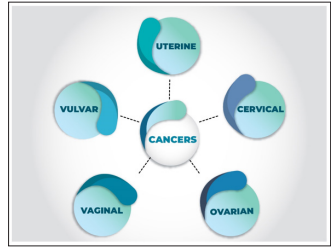
Figure 1: Classification of gynecological cancers
The UAE-NCR has reported the gynecologic cancer cases out of the total number [301/4299 (7.0%)], among the UAE population, during the year 2017. Non-UAE citizens in the UAE population accounted for a greater number of gynecologic cancers i.e., 213 (70.76%), whereas UAE citizens accounted for a smaller number of cases i.e., 88 (29.23%) (Table 1). The most diagnosed gynecologic cancers were uterine, cervix uteri and ovarian cancer, which ranked 5 th , 6th , and 8th , respectively among all female malignant cancers in the UAE [6].
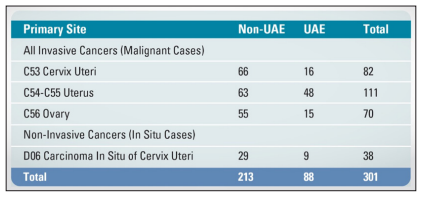
The UAE-NCR (2017) has reported the highest number of malignant cervix uteri, uterus, and ovary cases among the age groups of 35-39, 60-64, 50-54, respectively in the UAE population (Table 2) [6].
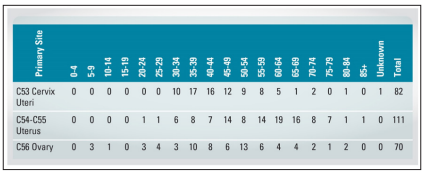
Uterine cancer is one of the most common gynecologic cancers in the UAE population [6]. This type of cancer initiates from the uterus; hence, it is termed as “Uterine Cancer” [12]. All women are at risk, except those who had hysterectomy, and the risk increases with the women’s age and obesity. There were 111 cases of uterus cancer, which accounted for 4.93% of all cancer cases among females, diagnosed in 2017. The highest number of uterine cancer cases has been reported in the age group of 60-64 (Figure 2) [6,12].

Figure 2: Age group distribution of uterine cancer in UAE, 2017
A very strong risk factor for endometrial cancer is obesity. Females with obesity-associated diseases e.g., diabetes, hypertension, and Polycystic Ovary Syndrome (PCOS) are also at high-risk of this disease [13]. The world obesity data report (2017-2018) has presented the obesity prevalence rate in both genders among local population of the UAE. This shows the adult female Emiratis have high overweight (29.3%) as well as obesity (41.8%) rate compared with the adult males [14].
According to the 2019 International Diabetes Federation statistics, the UAE has high prevalence diabetes rate (16.3%). Recently, a study conducted in Dubai showed exceptionally high prevalence of diabetes and pre-diabetes in their population. Furthermore, there was a lack of awareness among diabetic and pre-diabetic patients for their diagnosis [15,16]. As reported by a study in 2008, obese women have multiple times greater risk of developing endometrial cancer, regardless of menopausal status. The elevated risk of endometrial cancer has been associated with diabetes. Women with known diabetes have been affected with 3-folds elevated risk of endometrial cancer, independent of obesity. The relativity between obesity and diabetes with endometrial cancer in the UAE has not been studied until now [17].
The department of health in Abu Dhabi has initiated an excellent wellness program for their population, aged 18 years and above, “The Weqaya Program”. The screening for diabetes and obesityalso falls under the umbrella of Weqaya wellness program [18]. Also the Diabetes Prevention Program is one of the huge efforts done by the Ministry of Health and Prevention, UAE. This program provides education and training on diabetes- related healthy habits among the community [19].
The cervix uteri initiate from the cervix region. It occurs mostly in women over the age of 30 years [12]. Figure 3 shows the stage distribution of cervix uteri cancer cases in 2017. The highest number of cervix uteri cases has been reported in the age group of 35-39 in the UAE [6].
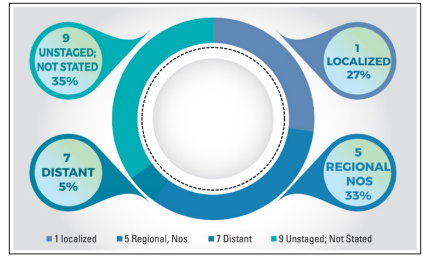
Figure 3: Stage distribution of cervix uteri cancer cases among UAE population, 2017
A study was conducted to evaluate the awareness among females in Sharjah for cervical cancer screening. The study reported that more than one-third (37.2%) of the adult females in the state had never been screened for cervix uteri. This number was comparable with other countries like Thailand (36.6%) and Qatar (40%). However, the elevated frequency of testing with increased levels of education had been reported by few studies like Turkey (59.13%). Only 79 (37.3%)/ 212 (62.73%) respondents had taken the pap smear test. Most of the participants had a very poor knowledge of the Pap smear test [20].
Cervix uteri is the 2 nd most prevalent female cancer after breast cancer in Abu Dhabi, United Arab Emirates. Nearly 99% of cervical cancers are long-lasting Human Papilloma Virus (HPV) infection of the cervix area. Vaccinations are most effective in preventing HPV infection among females [21]. The capital of UAE has become alert and since 2008, the UAE made free vaccination drive for the young female students of grade 11, across all schools in the region. Upon the success of this initiative, the vaccination program expanded for young females, aged 18-26 years. Taking cervical cancer prevention one step further, the Department of Health (DOH) implemented the screening program for cervical cancer in the same year. Hence, HPV vaccination was being recommended for females, aged 15-26 years and screening with a pap test for women 25-65 years, regardless of their HPV vaccination status [21].
In 2012, DOH launched the “Cancer Wave Health Promotion Project”, to create an awareness among the population on the importance of regular screening and timely diagnosis of prevailing cancers, namely, breast, cervical, and colorectal in the community. The Abu Dhabi Central Cancer Registry (ADCCR), a central repository of all cancer cases diagnosed in Abu Dhabi, has been established as an effort to curb the cancer in the country [21]. Consequently, due to these exceptionally well-established programs towards the prevention of cervical cancer, the UAE has been able to control the cervix uteri cases over a period of few years (Figure 4) where the rate of carcinoma in situ of cervix uteri in the UAE has declined by over 50% (from 81 cases in 2015 to 38 cases in 2017) [6,22,23].

Figure 4: The trendline of carcinoma in situ of cervix uteri (2015,2016, & 2017)
Ovarian cancer originates in the ovaries, or in the related areas of the fallopian tubes and the peritoneum [12]. Mutations in the BRCA1 and BRCA2 genes, and those associated with Lynch syndrome, can raise the ovarian cancer risk in the female population. There were 70 cases of ovarian cancer, accounted for 3.11% of all cancer cases among females, diagnosed in 2017. The highest number of ovarian cancer cases has been reported in the age group of 50-54 (Figure 5) [6,12].
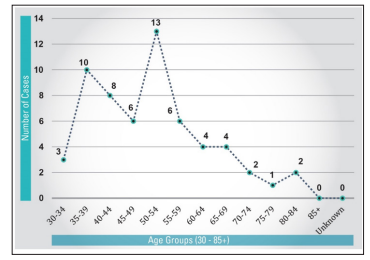
Figure 5: Age group distribution of ovarian cancer (C56) cases in UAE, 2017
Formerly, ovarian cancer was considered a silent killer, as it lacks the early symptom detection mechanism, causing the late presentation of the disease, ultimately leading to the high mortality rate among females [24]. The major risk factors of developing ovarian cancer increases with advanced age, family history of breast, ovarian, uterine and colon cancer, use of fertility drugs and nulliparity [25]. However, the relativity between awareness of aforementioned risk factors and ovarian cancer is generally poor among females [25,26].
The UAE has stepped up revolutionizing healthcare strategies that have an impact on controlling ovarian cancer. This initiated with the launch of Saudi genome project that aimed to sequence 100,000 genomes of Saudi population, followed by Qatar genome project, that intended to sequence ~300,000 genomes of Qatari population [27]. Recently, the UAE has also started to sequence thefirst 1,000 genomes of Emirati population, under the program “The National Arab Genome Project”. The utilization of NGS technology in this project provides complete genomic data of the participant, improves the understanding of Arab genome and catalog variants that are exclusive to the Emirati population of the UAE [28]. The expectation of these programs is to reform the healthcare structure in terms of genetic diseases and more informed decisions could be made. The UAE genomic project creates an in-depth understanding of pharmacogenomic factors, which are very significant among the UAE and Arab patients. The hereditary nature of ovarian cancer is one of the major risk factors of this disease. Thus, such programs can improve the timely prognosis of ovarian cancer, provision of suitable disease management, promote the customized tools of molecular diagnostics, aid in genetic counselling for mutational carriers, and possibly lead to the development of improved strategies for the prevention of ovarian cancer [25,27,28].
In 2020, a cross-sectional survey was conducted in the UAE that found a positive association between education level and awareness of ovarian cancer risk factors and symptoms. This demonstrates the importance of female education, as it makes women in a better position to approach the information regarding ovarian cancer. This study also showed that females were more knowledgeable about the risk factors of ovarian cancers compared with its symptoms [29].
The implementation of prevention strategies to enhance the level of understanding and knowledge regarding ovarian cancer symptoms and risk factors is much needed. This could be achieved by creating and airing awareness programs through various channels (TV, radio, leaflets, social media etc.). Investigation of potential interventions in ovarian cancer could be the next step to enhance the epidemiology research strategies in the country. The UAE can also consider the significance of regular lectures and workshops in general, as well as, in schools and universities [29].
The third leading cause of death in the UAE is cancer [30]. The malignant neoplasm of cervix uteri makes up to 1.9% of the total deaths (ranked 6 th ), caused by cancer in the UAE population, in 2017 (Figure 6) [6].

Figure 6: Distribution of mortality rate by the type of malignant cancer in UAE, 2017
The UAE-NCR has reported the highest number of malignant cervix uteri (94) as well as uterus cancer (127) in 2016, whereas the ovarian cancer cases (78) were reported to be the highest in the year 2014 (Figure 7) [6,22,23,31].

Figure 7: Overall malignant gynecologic cancer cases in UAE (2013-2017)

Figure 8: The trendline of malignant gynecologic cases in UAE population (2013-2017)
The total of malignant gynecologic cancer cases i.e., cervix uteri, uterus, and ovary among UAE population were highest in the year 2016, with a total of 290 cases. The trendline has been shown in Figure 8 [6,22,23,31].
The research on gynecologic cancers in the UAE is minimum. More studies should be conducted to target the female patients of the UAE, who are currently receiving different treatment modalities for gynecologic cancers. This kind of research would be a milestone in the survivorship track and surveillance field for the country. The gynecologic cancer patient goes through several emotional difficulties, mental trauma, the loss of fertility, menopausal symptoms, and sexual issues. Collectively, they may have a negative impact and affect the quality of survivorship.Healthcare Providers (HCPs) and cancer support groups should play an effective role in releasing, at minimum, the psychological distress that comes with these types of cancers.
The regulators should apply effective strategies to control the cancer morbidity and mortality rates in the country. The HCPs and cancer support groups should raise awareness campaigns for females regarding risk factors, prevention, screening, and overcoming barriers such as fear, social stigma, and embarrassment. The need for increasing the awareness of a sedentary lifestyle as a risk factor for many cancers, including gynecological, must be amplified in the community, and experts should endorse the adoption of a healthy lifestyle among youth.
The escalating incidence rate of gynecologic cancers in the UAE has made the health authorities take proactive steps to reduce such cancers. It has led to the initiation of huge steps like the National Cancer Registry, HPV vaccination drive, healthcare professionals’ workshops/training, awareness, and screening campaigns for females across the country. International collaborations are required to boost and foster the multidimensional care of female cancer patients throughout the UAE, by bringing together all the practicing cancer specialties and advanced technologies in the country. Furthermore, advanced diagnostic services and research are an absolute requirement for the UAE to curb gynecologic as well as other cancers too.
